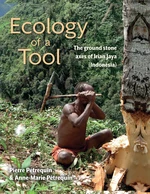New Guinea, and especially Papua New Guinea, is the last country in the world where ethnologists were able to closely observe, film and photograph the wholemanufacturing chaînes opératoires of polished stone felling tools, from quarryextraction to finished tool use. Research on the polished blades of PNG has evolvedover the years, following changing philosophies and research agendas. While it is clearthat an exceptional sum of information has been gathered, it remains centered on thatsmall part of the Highlands where conditions for field research were more pleasantthan elsewhere. Our presentation of Irian Jaya axes therefore tackles a topic thatremains mostly unexplored.Until now, stone tool research in New Guinea has followed an anthropocentricapproach, in which tools are seen more as vectors for social exchanges than as meansof acting on the environment. This monograph will take a different approach. Here,polished stone blades are placed at the center of the world, between, on one side, thetransformed natural environment, and, on the other, the social and economicenvironment. This approach will allow us to suggest new avenues of inference inarchaeology, as well as to test and abandon existing ones.In this volume, the stone blade is considered as a living being, existing in balancewithin its biotope. This idea is not far removed from the beliefs of Irian Jaya farmers,for whom life animates certain objects of their material culture.Following a brief presentation of Irian Jaya, we will describe the function of polishedstone blades in Irian Jaya societies and the distribution of hafting styles, define andstudy the quarrying zones and the areas of diffusion and use of their production, and,if possible, the different trends noted in each area of polished blade production andexchanges. Finally, we will conclude with a discussion of the ethnoarchaeologicalpotential of these contemporary observations.
Price history
Oct 25, 2021
€26.41

